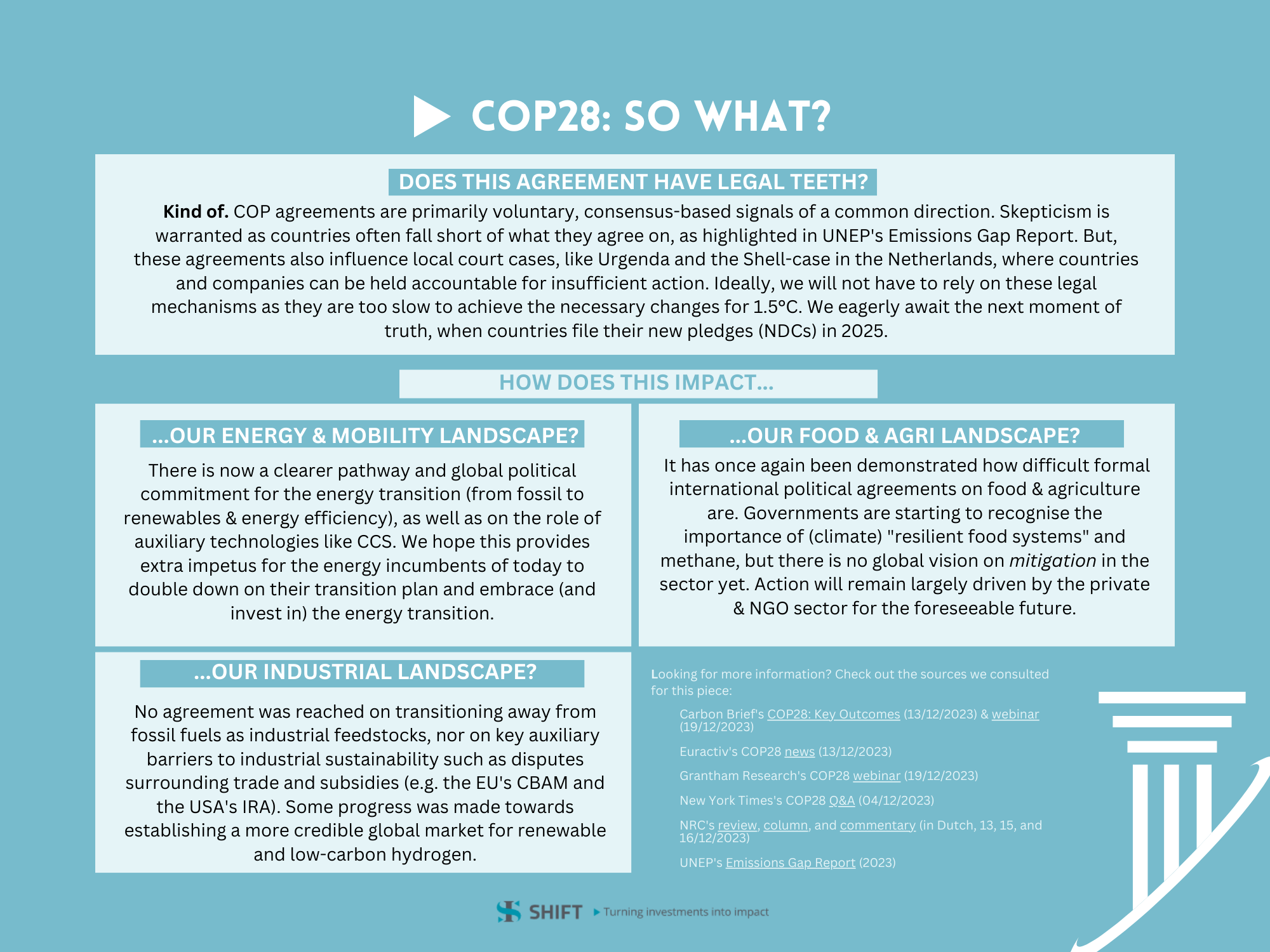COP28: so what?
COP28 is considered by some to be the most important Conference of the Parties since COP21 of the Paris Agreement. This is because it was the official moment of the first Global Stocktake to see how close we are to achieving the goals we set in Paris. It lays the groundwork for the national climate change mitigation plans (NDCs), which are due to be revised by 2025 for COP30. The conclusion? We have already reached 1.2°C warming and are on a trajectory to 3°. Although we have hereby won 1° from our pre-Paris trajectory, we are uncomfortably close to the 1.5° warming limit we agreed to strive for. The key conclusions of the stocktake are therefore (unsurprisingly):
- we are not cutting emissions quickly enough,
- we are not sufficiently prepared for climate hazards, and
- developing countries are recieving insufficient support.
We have rounded up the most important takeaways from the formal 'blue zone' negotiations and informal 'green zone' events at this year's COP, as well as our thoughts on this below (plus sources at the end).
Our main takeaway from the negotiated outcome? There is something to celebrate: the (unprescendented) explicit agreement to transition away from fossil fuels in the energy sector. But at the same time, no formal agreement was reached on climate change mitigation in food & agriculture and fossil-free industry. Dissapointing, but nonetheless another important reason to continue to back startups that enable these sectors to reduce their environmental footprint on our planet.

Key outcomes from the Blue Zone
(The Blue Zone is where the formal negotiations between nations take place.)
Click here for the final decision text
1. Fossil fuel phaseout & push for renewables
The undisputed highlight of COP28. International climate change agreement have until now never before explicitly named the main driver of climate change: GHG emissions from the combustion of coal, oil and gas. Now, there is a milestone agreement on the transition away from fossil fuels ("in energy systems"), plus tripling renewable energy capacity and doubling the annual rate of energy efficiency improvements by 2030. The diplomatic strength of the language is poor and includes caveats for transition fuels (gas), but this agreement is nontheless more concrete and quantitative than ever before.
2. Loss and damage fund
Small island states have been lobbying for 30+ years for a fund to cover losses and damage suffered as a result of climate change. Historically, this has been hampered by wealthy nations who fear having to pay compensation for historical emissions. The loss and damage fund was finally established at COP27, but major questions to be resolved at COP28 included who will pay and who will receive funds. An agreement was quickly reached: the fund is to be housed in the World Bank, under supervision of a board of developing countries. There is no firm payment obligation for developed countries. By the end of COP, the voluntary commitment to this fund amounted to $770.6M (covering >0.2% of developing countries’ annual needs).
3. Adaptation framework
Climate change adaptation has historically been under-addressed, mainly due to the finance and common-but-differentiated-responsibility debate. The COP28 agreement now establishes an adaptation framework including targets on water, food, health, ecosystems, infrastructure, poverty eradication and cultural heritage. Countries that have not yet done so are asked to prepare a national adaptation plan by 2050. The final agreement also contains some (very weak) language on adaptation finance and developing countries.
Plus some key topics where little to no meaningful progress was achieved
- Mitigation work programme: this was focused on identifying and accelerating the best clean energy pathways through to 2030 (power & transport). Negotiations didn’t really achieve anything due to mistrust amongst parties regarding who will bear the mitigation burden and how.
- Agriculture and food security: the goal of COP28 was to develop a recommendation report on this topic. Negotiations were unsuccessful, ending with an informal procedural text, i.e., “we’ll talk again”.
- Carbon markets (Article 6): COPs have repeatedly failed to come to an agreement on this. The outcome this year was also disappointing: the establishment of a quality benchmark is delayed, no guidance on bilateral carbon trading, and no international carbon credits market to name a few.
Key outcomes from the Green Zone
(The Green Zone is the venue for exhibits and side events by civil society organisations, academics, business groups and others.)
Fossil fuels
- 9 more countries have signed onto the Powering Past Coal Alliance, pledging to phase out unabated coal. A smaller group of countries has pledged to phase out fossil fuels more broadly with the Beyond Oil and Gas Alliance (incl., FR, DK, SWE, not NL).
- NL leads 12 countries in new joint statement on the need to phase out fossil fuel subsidies, committing to transparency to facilitate international dialogue to facilitate a phase out.
- Many national oil and gas companies (representing 40% of global production) signed an Oil and Gas Charter to reduce operational emissions associated with producing fossil fuels (e.g. end flaring and methane).
Renewables
- The EU launched the Global Pledge on Renewables and Energy Efficiency, targets to triple installed capacity (>11TW) and double the rate of global energy efficiency improvements (2 to 4% per year) by 2030. The EU also pledged €2.3bn to support the energy transition. Analysis by Climate Action Tracker describes this pledge as the key highlight of COP28, estimating that it could close about 1/3 of the gap between current policies and 1.5 °C in 2030 if fully implemented. (Notable absences from this initiative: China & India.).
- Utility and power companies launched the Utilities for Zero alliance, committing to advance electrification, renewables-ready grids, and clean energy deployment (incl. Schneider Electric, Siemens, E.ON, EDF).
- A declaration to triple nuclear energy was endorsed by 22 governments, including FR, UK, UAE, and USA (the latter also launched an international nuclear fusion plan).
Food and Agriculture
- Emirates Declaration on Sustainable Agriculture, Resilient Food Systems and Climate Action was signed by 134 parties (representing > ¾ of global food system emissions), recognizing climate impacts on agriculture and intending to integrate food systems into NDCs by 2025. More than 200 non-state actors signed an accompanying Call to Action for Food Systems Transformation, adding a call to transition away from fossil fuel use within food systems.
- Several financial pledges: $890m to research by CGIAR, $57m from the Bezos Earth Fund for food systems transformation, $47m from Norway mainly towards adaptation for smallholder farmers.
- Launch of the Alliance of Champions for Food Systems Transformation, with Brazil, Norway, Sierra Leone, Cambodia and Rwanda. Commit to reorienting policies, practices and investment priorities to deliver better food systems outcomes for people, nature and climate.
Other noteworthy announcements
- Brazil’s Tropical Forests Forever Fund, aiming to provide 80 countries with payments for conservation & restoration. Hopes to raise $250bn from sovereign wealth funds and other investors, incl. the oil industry. Want to create conditions for developed countries to protect the forest without it being charity (i.e., they will get a return).
- Two initiatives that focus on integrating actions of Global Biodiversity Framework and Paris: Joint Statement on Climate, Nature and People & High Ambition Coalition for Nature and People.
- +5 countries sign Global Methane Pledge, committing to reduce methane emissions worldwide by 30% by 2030. Companies like Danone, Nestlé and Kraft Heinz also committed to report and reduce their methane emissions.
- Germany and Chile launch Climate Club to facilitate the decarbonisation of heavy industry in developing and emerging economies (with technical and financial assistance).
- 66 countries sign Global Cooling Pledge to reduce cooling-related emissions across all sectors by 68% by 2050 (based on 2022 levels).
-----------------------------------------------------------------------------------------------------------------------------------------
Looking for more information? Check out the sources we consulted for this piece:
- Carbon Brief's COP28: Key Outcomes (13/12/2023) & webinar (19/12/2023)
- Euractiv's COP28 news (13/12/2023)
- Grantham Research's COP28 webinar (19/12/2023)
- New York Times's COP28 Q&A (04/12/2023)
- NRC's review, column, and commentary (in Dutch, 13, 15, and 16/12/2023)
- UNEP's Emissions Gap Report (2023)
